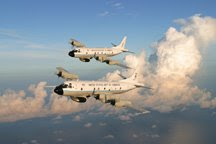Sorry for the long break in my postings. Following Hurricane Ike, for which I made a couple of postings, we immediately had TS Kyle which was born just south of Hispanola and moved north. It was of interest to our research folks because it at one time posed a threat to the East Coast and thus needed an all out effort from our P-3s and G-IV. Following Kyle, we all took a week to get back on track as many of the crew were exhausted. So much flying had been done in the 30 day period that involved Gustav, Hanna, Ike and Kyle that many of the crew reached their legal limit of flight hours in this period that they had to receive a waiver from our flight surgeon just to complete the flights into Kyle. So, you didn't know there was a limit to how many hours any crew member, be it on a commercial airline or on a government aircraft, can fly. Well, there is, and with that and other things in mind, I thought I'd use this relatively quiet time (well, not too quiet - there are four systems in the Atlantic and Caribbean as I write this, but none pose a threat to the U.S. or are of interest to our research team) to give you some facts and figures about our flight program.
The legal limit for flight hours that any crew member, pilot, technician, scientist or whomever, may accumulate in a 30 consecutive day period is 120 hours. To fly more than this number one must request and be granted a waiver by a flight surgeon or physician so authorized to perform this function. Now, you may not think 120 hours in a month is very many, but try flying almost 9 hours each day during 15 of those 30 days, and perhaps you may have some feel for how exhausting it might be. Add to the flight time the effort it takes to prepare for each mission, and these hours become telling. As always, though, we manage.

If you would like to know what it costs to fly one of these missions on a P-3. Here's the story.
If we forget about what we called "fixed" costs, that's salaries, the cost of running the facility, etc., we have left what we call the "variable" costs. These include fuel, premium pay (overtime, weekend pay, night time differential, holiday pay and hazard duty pay), satellite communication (satcom) charges and miscellaneous expenses such as landing and parking fees, shipping, travel expenses, transportation, lavatory fees, facility servicing fees, etc. Dropsondes are a separate charge which we don not include in our flight hour cost, but I'll throw those in anyway as they are a mission relate cost. Already I think you have the feeling that it isn't cheap. Well, here's a look.
Operating from our home base at MacDill AFB in Tampa, FL, the miscellaneous fees are non-existent. So, it's a lot less expensive (I use that term rather than "cheaper" for good reason). That leaves us with fuel charges and premium pay. Here's how that breaks down.
On a typical 9 hour flight we will use 6,750 gallons of Jet fuel. At the Air Force base where from which we operate we currently pay $4.26 per gallon for this fuel. So that you don't have to do the math, that comes to $28,755, or $3,195 per flight hour. Satellite communications (Satcom) - on a typical hurricane flight this averages about $2,500 per flight. Premium pay can run an additional $5,000 per flight.
On an normal hurricane flight we will drop on average 20 dropsondes. These cost about $725 each. So add another $15,000 to the total.
Let's add up these charges.
Fuel: $28,755
Satcom: $2,500
Prem. Pay: $5,000
Total: $36,255, or about $4,300 per flight hour.
Throw in the dropsondes at $15,000 and the total rises to: $51,255.
On a given storm, we may do 8 flights in succession over a four day period, so inside of a week we've spent over $290,040 for flight hour expenses and another $120,000 for dropsondes. Ouch!
When we deploy to a foreign base, the price goes up significantly because of employee travel costs and all of the other miscellaneous expenses I mentioned above. On average, it costs a bit more than $5,500 per flight hour, not including dropsondes, to operate the P-3s during the hurricane season. As a comparison, it only costs about $3,360 per flight hour to operate the Gulfstream G-IV. But then they drop about 10 more sondes per flight, so the costs come out about even.
Thought I'd leave you with this. Although these costs are high, the value of the data obtained to improved forecasts and the saving of lives is far greater and probably not calculable. Like everything in life - it's all relative.
Season is winding down. I will probably have another posting or two to conclude this blog. I do appreciate your taking the time to read it, and I look forward to repeating it next hurricane season.
Thank you.





















































